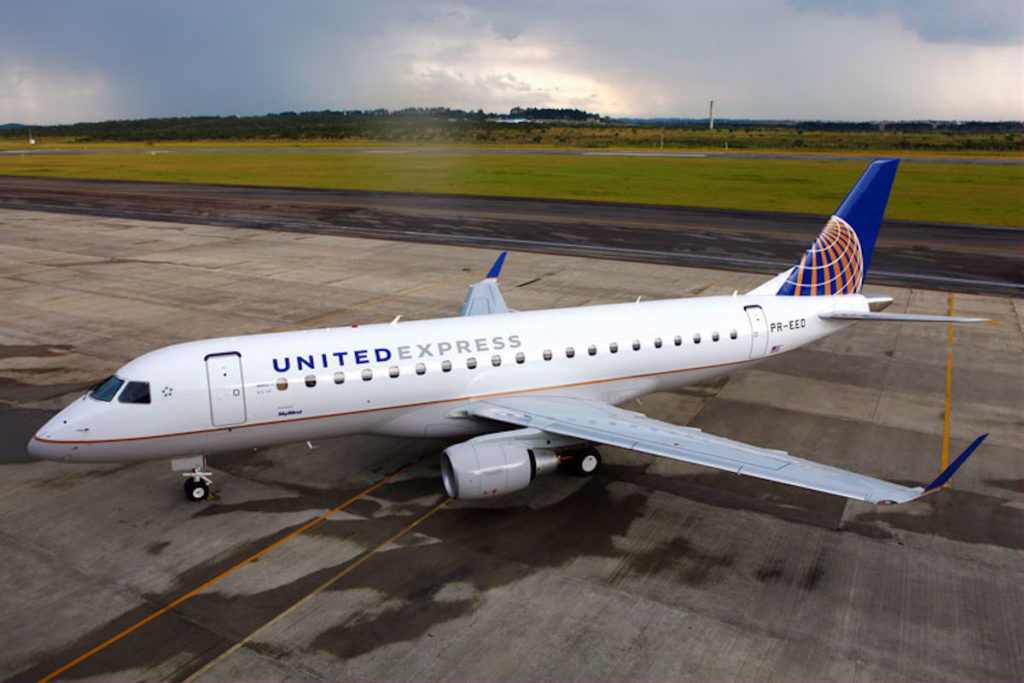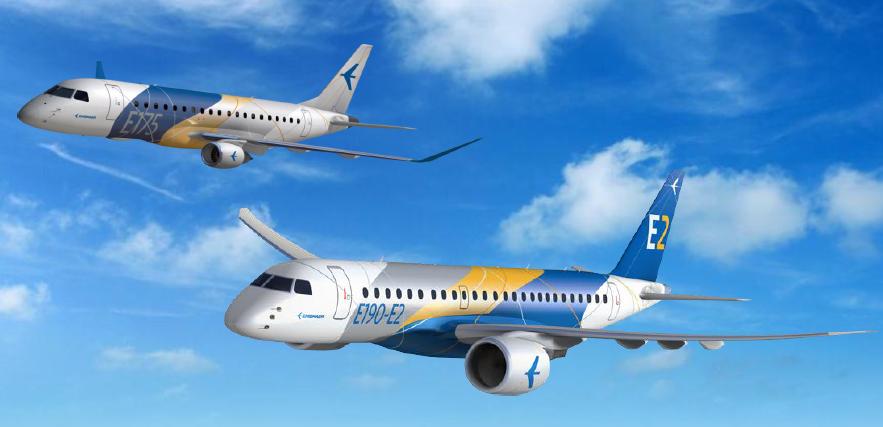Leeham News and Analysis
There's more to real news than a news release.
Leeham News and Analysis
- Boeing ponders 16/mo production rate for 787
- At long last, Boeing appears near certification and EIS for 777X
- Air India Flight 171 Preliminary Crash Report Is Unclear Regarding Pilot Actions
- Bjorn’s Corner: Air Transport’s route to 2050. Part 30.
- It’s official: MTU’s engine leader named CEO of Airbus Commercial from Jan. 1; future of Open Fan and A220-500 shifts to him
Embraer’s improved E-Jet E2
By Bjorn Fehrm
Subscription Required
Introduction
December 07, 2017, © Leeham Co.: Embraer is four months from first service introduction of the new generation E-Jet, the E190-E2, with Norway’s Wideroe. Following the smooth E190-E2 program will be the larger E195-E2 in 2019.
Embraer’s E2 update of the E-Jet is more elaborate than the Airbus A320neo and Boeing 737 MAX updates. In addition to new engines, the aircraft’s wings and systems are changed. In addition, the fuselages are stretched on two of the three models for increased passenger capacity.
We analyze the areas of change from the original E-Jets and what these mean for the operations and economics of the aircraft.
Summary:
- The E-Jet E2 keeps the strong point of the original E-Jet, its comfortable cabin, and improves other areas to keep the family competitive after 2020.
- As the only aircraft family in the market (regional or mainline), the E2 models E175, E190 and E195 all get their own optimized wings. The result is good field and range performance paired with low fuel consumption.
- The E2 family introduces advanced Digital Fly-By-Wire to allow reduced static stability and by it trim drag. This improves the fuel consumption further.
- Other system changes focus lower maintenance costs. The new single-aisle generation (A320neo, 737 MAX) lowers maintenance costs per seat. The regional OEMs must respond.
Posted on December 7, 2017 by Bjorn Fehrm
Assessing Alaska Air Group’s fleet requirements
Subscription Required
Introduction
Oct. 27, 2017, © Leeham Co.: Alaska Airlines Group (AAG) acquired Virgin America (VA) and with it, Virgin’s exclusive fleet of Airbus A320ceos with orders for A320neos and A321neos.
With Alaska Airlines (AS) being an all Boeing 737 operator, the question immediately arose: what will AAG do with the Virgin fleet.
AAG CEO Brad Tilden strongly hinted the Airbuses will eventually go away. But on earnings calls, officials say they’re studying the matter and there’s plenty of time before they must decide since the first leases don’t begin rolling off until 2019.
Even if AAG decides to consolidate around the 737—an issue still very much in doubt—it won’t be any time soon.
The A320 leases continue to 2024. The leases for the new A321neos go longer: these are 12-year leases and they are non-cancellable. The A321neos will be around at least until 2030.
Posted on October 30, 2017 by Scott Hamilton
Boeing-Embraer venture in response to Airbus-Bombardier? Don’t count on it
Subscription Required
Introduction
Oct. 23, 2017, © Leeham Co.: With the tie-up announced last Monday between Airbus and Bombardier for the CSeries, speculation immediately turned to whether Boeing and Embraer will join forces in some fashion in response.
The speculation is natural. Boeing and Embraer have had several commercial agreements, mostly on the defense side but also in eco-research. But as yet, there hasn’t been a tie-up involving the successful E-Jet program.

Embraer E195-E2.
Don’t look for anything soon that would be a meaningful response to the Airbus-CSeries deal.
Summary
- Boeing needs a response in the 125-150 seat sector in which the 737-7 MAX languishes and with which the CS300 competes.
- Boeing has no product offering in the 100-125 seat sector. Embraer doesn’t need Boeing’s help here. The E175-E1 continues to sell and it meets US Scope Clauses.
- The Embraer E2 program’s first delivery is April next year.
- Embraer isn’t about to proceed with a new airplane program in the 100-150 seat sector, which is Boeing’s product gap.
Posted on October 23, 2017 by Scott Hamilton
Mid-Year production/delivery update: Bombardier, Embraer
Subscription Required
Introduction
July 31, 2017, © Leeham Co.: It’s time for our mid-year update of the Big Four airframe manufacturers and their production/delivery outlooks.
Our update is through June 30. Although Boeing provides weekly order updates, Airbus, Bombardier and Embraer only do so monthly.
Our update data relies on the Airfinance Journal Fleet Tracker.
Today we look at Bombardier and Embraer.
Summary
- Bombardier’s CSeries production skyline is said by the company to be sold out through 2019, but there are some “dicey” customers as early as next year.
- BBD’s big challenge comes in 2020, given the goal of producing 120 airplanes a year.
- The CRJ and Q400 lines continue to be a major challenge.
- Embraer’s production line looks nearly full in 2018, but it, too has some customer issues.
Posted on July 31, 2017 by Scott Hamilton
Pontifications: JADC 20-year forecast: VLA, NMA and other data
July 24, 2017, © Leeham Co.: The Japan Aircraft Development Corp (JADC) just published its 2017-2037 jet and turboprop forecast. JADC forecasts a demand for 33,336 jet airliners and some 2,000 turboprops.
JADC is partly owned by Mitsubishi, which is developing the MRJ70/90 and which is on several Boeing programs.
I like the JADC forecast because it segments the seating categories in more detail than Airbus and Boeing and somewhat differently than Bombardier and Embraer.
I also view JADC as having less of an axe to grind than the Big Four OEMs.
A couple of quick take-aways:
Posted on July 24, 2017 by Scott Hamilton
Airbus, ATR, Boeing, Bombardier, CSeries, E-Jet, Embraer, Middle of the Market, Mitsubishi, MOM, Paris Air Show, Pontifications, Sukhoi
Air Canada, Airbus, ATR, ATR 42, ATR-72, Boeing, Bombardier, Cebu Pacific, CS100, E190, Embraer, JADC, Japan Aircraft Development Corp., Mitsubishi, MRJ70, MRJ90, New Midrange Aircraft, NMA, SSJ100, Sukhoi
Jet sales in 75-150 seat lag Airbus, Boeing
Subscription Required
Introduction
July 13, 2017, © Leeham Co.: While analysts and reporters focus on the high-profile order competition between Airbus and Boeing, it’s time to look at Bombardier and Embraer, along with the 75-150 seat sector.
Boeing is doing better than expected this year, due largely to the launch of the 737 MAX 10. Airbus is struggling year-to-date, but received a big boost post-Paris Air Show with an agreement to sell 140 A320s and A350s to China. At this stage, it’s not a firm order, however.
How are Bombardier and Embraer doing in their core markets of 75-150 seats?
Just awful.
Sukhoi and Mitsubishi aren’t doing any better.
Summary
- Few new sales in 2017 in the 75-150 seat sector.
- Low fuel prices, Scope Clause and general order downturn converge.
- Embraer’s Paris Air Show results boosted this OEM’s year-to-date performance.
Posted on July 13, 2017 by Scott Hamilton
Embraer adds range to E190/95 E2s
June 2, 2017, © Leeham Co.: Embraer today announced enhancements to its new E190-E2 and E195-E2 adding range to the 195 and improving hot-and-high and challenging airport performance for the 190.
John Slattery, president and CEO of Embraer Commercial Airplanes, revealed the improvements during its media days at its Melbourne (FL) facilities.
Posted on June 2, 2017 by Scott Hamilton
Embraer’s US footprint spans 31 states
June 2, 2017, © Leeham Co.: Embraer is best known as a Brazilian company, but its US footprint and economic contributions are surprising for those who don’t delve into these sorts of things.
Gary Spulak, president, Embraer Aircraft Holding US, outlined EMB’s US presence on the first day of two days of pre-Paris Air Show briefings at the company’s Melbourne (FL) engineering, production and corporate aircraft center.
Posted on June 2, 2017 by Scott Hamilton
Regional aircraft for US Scope clause operations. Part 3.
By Bjorn Fehrm
Subscription Required
Introduction
May 18, 2017, © Leeham Co.: In the second article about the US regional aircraft market, we looked at the cabins for the regional aircraft we examine. We started with looking at the typical classes and their seat ratios for the mainline aircraft the regional aircraft are feeding to/from. Then we mimicked that on the regional aircraft.
We filled the cabin with domestic First-class seats, then Premium economy and finally Economy until we got 76 seats or the cabin said stop.
 Now we complete the picture by comparing the economics of the aircraft after which we summarize our findings.
Now we complete the picture by comparing the economics of the aircraft after which we summarize our findings.
Summary:
- The benchmark aircraft for the US scope clauses is the E175 from Embraer. It was designed for the scope clause market.
- It’s larger dimensions means the operating costs are slightly higher than the CRJ900.
- A scope clause-bound operator can compensate the Bombardier CRJ900’s tighter cabin with more seat pitch. It has the longest cabin of all compared aircraft.
- The MRJ70 and CRJ700 are too short for scope clause flying with 76 seat cabins and the MRJ90 is too heavy for the 86,000lb maximum weight limit.
Posted on May 18, 2017 by Bjorn Fehrm
Regional aircraft for US Scope clause operations. Part 2.
By Bjorn Fehrm
Subscription Required
Introduction
May 11, 2017, © Leeham Co.: In the first article about the US regional aircraft market, we described the special rules that apply for outsourced regional airlines, operating for a mainline carrier. The mainline pilots limit the outsourcing via Scope clauses in their Union agreements to aircraft with 76 seats and 86,000lb Maximum Take-Off Weight (MTOW).
We identified potential aircraft that fit these restrictions in the first article. Now we examine their load carrying capability.
 The MTOW limit sets a hard limit on how large aircraft can be used to house 76 seats. The mainline carriers want the regionals to mimic their domestic cabin classes in their aircraft. There shall be no disruption for a First class or Premium economy passenger whether on a mainline flight or on a feed flight to/from the hub.
The MTOW limit sets a hard limit on how large aircraft can be used to house 76 seats. The mainline carriers want the regionals to mimic their domestic cabin classes in their aircraft. There shall be no disruption for a First class or Premium economy passenger whether on a mainline flight or on a feed flight to/from the hub.
The challenge is to accommodate the seating standard in the aircraft that come in question.
Summary:
- Mainline airlines want to replicate their three class cabins for all sectors of a network.
- This means the regional aircraft cabins shall offer First class, Premium economy and Economy sections.
- Only the larger aircraft we study can offer a three class cabin with 76 seats.
Read more
Posted on May 11, 2017 by Bjorn Fehrm





